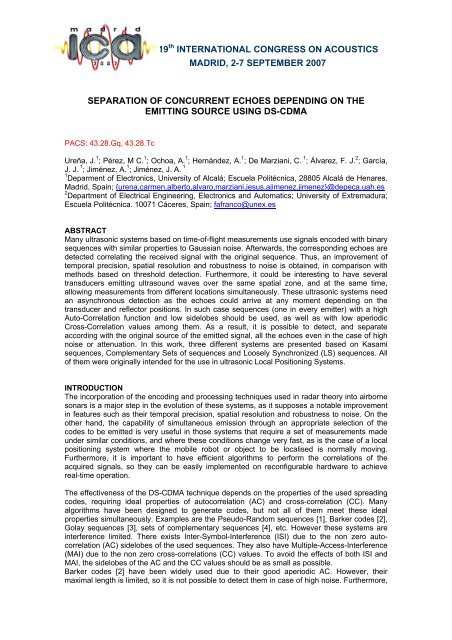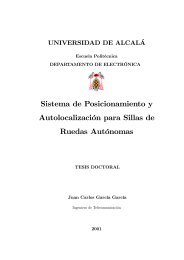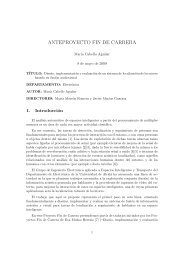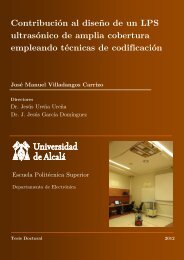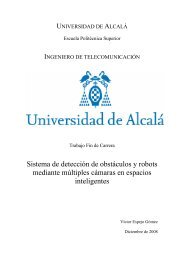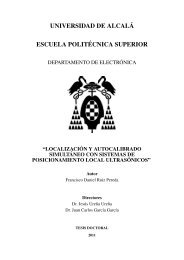autocorrelation
19th INTERNATIONAL CONGRESS ON ACOUSTICS ... - Geintra
19th INTERNATIONAL CONGRESS ON ACOUSTICS ... - Geintra
- No tags were found...
You also want an ePaper? Increase the reach of your titles
YUMPU automatically turns print PDFs into web optimized ePapers that Google loves.
19 th INTERNATIONAL CONGRESS ON ACOUSTICSMADRID, 2-7 SEPTEMBER 2007SEPARATION OF CONCURRENT ECHOES DEPENDING ON THEEMITTING SOURCE USING DS-CDMAPACS: 43.28.Gq, 43.28.TcUreña, J. 1 ; Pérez, M C. 1 ; Ochoa, A. 1 ; Hernández, A. 1 ; De Marziani, C. 1 ; Álvarez, F. J. 2 ; García,J. J. 1 ; Jiménez, A. 1 ; Jiménez, J. A. 11 Deparment of Electronics, University of Alcalá; Escuela Politécnica, 28805 Alcalá de Henares.Madrid, Spain; {urena,carmen,alberto,alvaro,marziani,jesus,ajimenez,jimenez}@depeca.uah.es2 Department of Electrical Engineering, Electronics and Automatics; University of Extremadura;Escuela Politécnica. 10071 Cáceres, Spain; fafranco@unex.esABSTRACTMany ultrasonic systems based on time-of-flight measurements use signals encoded with binarysequences with similar properties to Gaussian noise. Afterwards, the corresponding echoes aredetected correlating the received signal with the original sequence. Thus, an improvement oftemporal precision, spatial resolution and robustness to noise is obtained, in comparison withmethods based on threshold detection. Furthermore, it could be interesting to have severaltransducers emitting ultrasound waves over the same spatial zone, and at the same time,allowing measurements from different locations simultaneously. These ultrasonic systems needan asynchronous detection as the echoes could arrive at any moment depending on thetransducer and reflector positions. In such case sequences (one in every emitter) with a highAuto-Correlation function and low sidelobes should be used, as well as with low aperiodicCross-Correlation values among them. As a result, it is possible to detect, and separateaccording with the original source of the emitted signal, all the echoes even in the case of highnoise or attenuation. In this work, three different systems are presented based on Kasamisequences, Complementary Sets of sequences and Loosely Synchronized (LS) sequences. Allof them were originally intended for the use in ultrasonic Local Positioning Systems.INTRODUCTIONThe incorporation of the encoding and processing techniques used in radar theory into airbornesonars is a major step in the evolution of these systems, as it supposes a notable improvementin features such as their temporal precision, spatial resolution and robustness to noise. On theother hand, the capability of simultaneous emission through an appropriate selection of thecodes to be emitted is very useful in those systems that require a set of measurements madeunder similar conditions, and where these conditions change very fast, as is the case of a localpositioning system where the mobile robot or object to be localised is normally moving.Furthermore, it is important to have efficient algorithms to perform the correlations of theacquired signals, so they can be easily implemented on reconfigurable hardware to achievereal-time operation.The effectiveness of the DS-CDMA technique depends on the properties of the used spreadingcodes, requiring ideal properties of <strong>autocorrelation</strong> (AC) and cross-correlation (CC). Manyalgorithms have been designed to generate codes, but not all of them meet these idealproperties simultaneously. Examples are the Pseudo-Random sequences [1], Barker codes [2],Golay sequences [3], sets of complementary sequences [4], etc. However these systems areinterference limited. There exists Inter-Symbol-Interference (ISI) due to the non zero <strong>autocorrelation</strong>(AC) sidelobes of the used sequences. They also have Multiple-Access-Interference(MAI) due to the non zero cross-correlations (CC) values. To avoid the effects of both ISI andMAI, the sidelobes of the AC and the CC values should be as small as possible.Barker codes [2] have been widely used due to their good aperiodic AC. However, theirmaximal length is limited, so it is not possible to detect them in case of high noise. Furthermore,
there are no Barker codes with low CC among them. Pseudo-random sequences such as m-sequences, Gold codes or Kasami codes, exhibit non zero off-peak AC and CC values in thecase of asynchronous transmissions. Another possibility is Golay pairs, which have goodaperiodic correlation properties, and their length is not limited. Nevertheless, they provide onlytwo mutually orthogonal pairs, which is not useful for multi-user environments. Complementarysets of M sequences (M-CSS) are a generalization of Golay codes containing more than twosequences. The elimination of the constraint in the number of sequences of a set yields on ahigh process gain and also M mutually orthogonal sets. To achieve these goals, it is necessaryto add the AC functions of the sequences of the set, or the CC functions of the correspondingsequences in the M sets, respectively. The problem is that, in many systems, transducers havelimited bandwidths, so it is not possible to transmit or receive the M sequences of the setsimultaneously. Unfortunately, it implies an undesired increase of both ISI and MAI. Thedetection of Golay pairs or M-CSS can be performed by means of efficient correlationalgorithms which notably decrease the computational load and hardware complexity [10].Loosely Synchronized (LS) codes [6] exhibit an Interference Free Window (IFW), where theaperiodic AC sidelobes and CC values become zero. Consequently, ISI and MAI are completelyreduced if the maximum transmission delay is less than the length of the IFW.As the application of DS-CDMA in airborne ultrasonic systems deals with band-limitedtransducers and asynchronous detection, in this work, three kinds of sequences with the besrperformance are presented: Kasami sequences, Complementary Sets of sequences andLoosely Synchronized (LS) sequences. All of them are here intended for the use in advancedultrasonic sensors or in ultrasonic Local Positioning Systems.The paper is organized as follows. Section II introduces the general structure and block diagramof the detection method. In Section III the aforementioned sequences for asynchronousdetection are presented. Section IV shows how these sequences are used in LPS applicationsand, finally, some conclusions are outlined in Section V.GLOBAL STRUCTURE OF THE ULTRASONIC SYSTEMFig. 1 shows a schematic representation of the global structure of a Local Positioning System(LPS). A set of hardware synchronized beacons are placed at known positions of theenvironment, and all of them cover a determined area by emitting periodically a codedsequence (a different code each beacon). A non-limited number of portable receivers computetheir own positions from the measurement of Differences of Times Of Arrival (DTOAs),according to an hyperbolic triangulation algorithm (all the signals are asynchronously detected).At every position, the specific portable receiver has to detect at least 4 beacons for 2Dpositioning, or 5 beacons for 3D positioning.a) b)Figure 1.- LPS configuration (a) and signal processing in a receiver (b).The acquisition system converts the signal received by the ultrasonic transducer into a digitalsignal, which is demodulated to extract the transmitted information from the received signal. Asthere is no temporal reference in the receiver, the non-coherent demodulation is carried out by219 th INTERNATIONAL CONGRESS ON ACOUSTICS – ICA2007MADRID
digital correlation with the modulation symbol. Later, K correlators simultaneously correlate thedemodulated signal with the K ideal emitted sequences. In the precise moment at which the lastsample of a received sequence is processed, a peak in the correlator for this sequence isobtained. A peak detector confirms the maximum values exceeding a threshold, assuming thatthere is not a higher peak in the neighborhood.SEQUENCES FOR ASYNCHRONOUS DETECTIONThe purpose of this section is to evaluate the performance of Kasami sequences,Complementary Sets of M Sequences (M-CSS) and Loosely Synchronized (LS) sequences asencoding sequences for an ultrasonic beacon-based Local Positioning System (LPS). Asseveral transducers will emit ultrasound waves simultaneously over the same zone, theencoding sequences should bear very low cross-correlation (CC) values to provide adequatediscrimination among users. This is critical to control the multiple-access-interferences (MAI) insituations where there are large differences in the relative power level of the received signals.Furthermore, the sequences should have sharp auto-correlation (AC) functions, with very lowsidelobes, to minimise the inter-symbol-interference (ISI) and provide higher processing gains.Small set of Kasami sequencesSmall set of Kasami sequences were first discussed in [5] to improve the cross-correlation (CC)properties of other pseudo-random codes. Basically, the set of Kasami sequences consists of2 n/2 sequences with length L=2 n -1, being n an even integer, whose AC sidelobes and CCperiodic functions take values from the set {-1, -2 n/2 -1, 2 n/2 -1}. Both the periodic and aperiodicmaximum AC value is L; nevertheless, the other aperiodic correlation values are not within thisset. The aperiodic correlation properties of Kasami codes are analyzed in [6]: the maximum oddCC value for any pair of Kasami sequences is 2 n-1 +2 (n-2)/2 +1, whereas the maximum periodicCC value (also called even CC value) is 2 n/2 +1.The correlation of Kasami sequences is carried out by means of straight-forward matched filterimplementations, in case of short sequences, or by Fast-Fourier-Transforms (FFTs) in case oflarger ones [8]. These implementations provide large processing cost; and in case of largeamount of data to be processed, real-time operation is difficult to achieve.Complementary Sets of M SequencesM-CSS are sets of M sequences with length L=M N whose elements are either {+1,-1}, whereM=2 m , being m and N any natural number different from zero. The addition of the aperiodic ACfunctions of the M sequences from that set is zero everywhere, except for the zero shift wherehas a maximum value of M•L. Furthermore, it is possible to obtain M mutually orthogonal sets.Nevertheless, since more than one sequence encodes a user, a bit emission order has to beused. This implies a degradation of the ideal AC and CC properties: neither the AC sidelobes,nor the CC values for two orthogonal sets are null anymore. As it is desirable that all thesequences in the set are equally affected by changes in the environment, a transmissionmethod based on interleave their bits is carried out. In [9] this method it is compared with linkingconsecutively the sequences of the set; also a post-processing algorithm is proposed to reducethe degradation in the AC and CC values.The detection of M-CSS can be done with efficient correlation algorithms that notably decreasethe computational load and hardware complexity, in comparison with straight-forwardimplementations. The hardware implementation of this efficient correlator adapted to thetransmission scheme by interleaving is analyzed in [10]. It has been checked that, for equallylong interleaved sequences, less hardware resources are required for cases generated from M-CSS with low number M of sequences.Loosely Synchronized CodesLS codes exhibit an Interference Free Window (IFW), in a certain vicinity of the cero shift, wherethe aperiodic AC sidelobes and CC values become zero. Consequently, if the time offsetsbetween the codes, expressed in terms of number of chips intervals, are within the IFW, bothISI and MAI can be eliminated thoroughly.319 th INTERNATIONAL CONGRESS ON ACOUSTICS – ICA2007MADRID
These codes exploit the properties of orthogonal 2-CSS (better known as Golay pairs) [11]. Thenotation LS(N,K,W 0 ) has been adopted, where N is the length of the Golay pairs; K is thenumber of available codes with orthogonal properties in the IFW (K=2 n , n Є |N); and W 0 is thenumber of zeros to insert in the middle of the sequence during its construction (usually W 0 =N-1). The total length of LS codes is given by L=KN+W 0 , whereas the length of the IFW is given byW=min{2N-1,2W 0 +1}. The AC peak of a LS sequence is equal to K•N, while the AC sidelobesand CC values within the IFW are zero. However, the AC and CC functions exhibit highervalues outside the IFW than Kasami and M-CSS. Therefore, to minimize ISI and MAI themaximum dispersion of the channel (denoted by T d ) should satisfy Td≤W 0 .The correlation of these codes can be carried out by means of an Efficient LS Correlator (ELSC)[12] which significantly reduces the total number of operations performed. Also, this correlatorcan be easily implemented in hardware configurable to achieve real-time operation.Sequences comparisonA direct comparison of the interferences caused by AC sidelobes and CC values in the threetypes of codes indicates that LS codes are more adequate, in case that the receivedtransmissions arrive within the IFW. Nevertheless, if this cannot be assured, more serious MAIand multipath interferences will be encountered. Kasami codes are a good solution, as theyposses low correlation interferences within all the correlation function (M-CSS’s interferencesare higher). However, when longer sequences have to be processed in real-time, the increasingin the computational load demands the use of efficient correlators, which does not exist forKasami codes, so M-CSS have to be selected. Hence, it is inconclusively which of the threecodes are better suited; they have to be chosen depending on the particular applicationcharacteristics.Fig. 2 shows the correlation properties for the case of Kasami sequences with length 255 bits(a); of interleaved CSS sequences with length 256 bits and generated from sets of fourcomplementary pairs (b); and of LS(64,4,63), that is, of LS sequences with length 319 bits andan IFW of 129 bits (c). For each family of sequences, those who have the better performance incase of four simultaneous users have been chosen. Notice that the AC peak of Kasami andinterleaved CSS is equal to their length, but the AC peak of LS sequences it is equal to K•N.a) AC and CC functions for Kasami sequences with length 255 bits.b) AC and CC functions for Kasami sequences with length 255 bits.c) AC and CC functions for LS(64,4,63).Figure 2.- Correlation functions for Kasami, M-CSS and LS codes.419 th INTERNATIONAL CONGRESS ON ACOUSTICS – ICA2007MADRID
LOCAL POSITIONING SYSTEMSome simulations have been achieved to evaluate the feasibility of the previous codes in a LPS.The system is composed by a group of five beacons, which can be codified with Kasami, M-CSS or LS codes. These codes have been BPSK modulated by using a symbol with one periodof a 50KHz square signal. The five beacons are placed over the floor with a height of 3m, andinto a 1m x 1m surface, whereas the robot has been located at the coordinates (x=0.2m,y=0.1m, z=0.3m), as can be seen in Fig. 3. All the beacons are synchronized by a commonclock and they periodically emit their corresponding code every 50ms. The emissions aredigitalized with a sampling frequency of 500 kHz, demodulated and the correspondingcorrelations are carried out. A signal-to-noise ratio of SNR= 0dB has been assumed.a) b)Figure 3.- a) Scheme of the beacons distribution. b) Kasami signals received with a SNR=0dB.Firstly, the beacons are encoded with five pseudo-orthogonal Kasami codes with length 1023bits, thus the duration of the signals is 1023•20μs=20.46ms. Fig. 4.a) depicts the correlatoroutput for the emission from beacon 2. The maximum values indicating the TOAs of everyemission can be clearly observed. A similar detection has been carried out with interleaved 32-CSS (the final length of the emitted macro-sequence is of 1024 bits). Fig. 5 shows thecorrelation results from beacon 2.Figure 4.- Correlation output from beacon 2, in case of a SNR=0dB: a) 1023-Kasami codes, b) Macrosequencefrom 32-CSS and c) LS(128,8,127).Finally, every beacon has been encoded with a LS(128,8,127): a 1151-bit LS code with an IFWof 255 bits. Thus, the duration of the signal is 23.02ms, and the maximum delay among the519 th INTERNATIONAL CONGRESS ON ACOUSTICS – ICA2007MADRID
arrival of the diferent emissions is T dmax =127•20μs=2.54ms. Fig. 4.c) depicts the output ofcorrelator 2, where the IFW can be observed.CONCLUSIONSA local positioning system based on the use of Kasami, interleaved M-CSS and LS sequenceshas been presented. It consists of using simultaneous emission from ultrasonic beacons. Everybeacon is encoded with a particular sequence.The differences between sequences have been pointed out: all of them perform very well inasynchronous detection. Kasami and interleaved M-CSS have good properties in all theirs<strong>autocorrelation</strong> and crosscorrelation functions. On the other hand LS codes have theparticularity of having a perfect auto-correlation and cross-correlation functions in the IFW.The mobile receiver does not require knowing the emission instant, and therefore, there is notnecessary a synchronism trigger signal between the receiver and the beacons. The systemallows a non-limited number of mobile receivers working in the same environment.It is important to remark that interleaved M-CSS and LS codes admit the use of efficientcorrelators, and then real-time operation is easier to be achieved.Finally, the performance of the system has been tested by simulation.ACKNOWLEDGMENTSThis work has been possible thanks to the Madrid Community (INCUBUS: CAM-UAH2006/016),from the Spanish Ministry of Science and Technology (RESELAI: TIN2006-14986-CO2-01) andSpanish Ministry of Promotion (VIATOR: ref 70025-T05).References:[1] Chow, A. “Performance of Spreading Codes for Direct Sequence Code Division Multiple Access (DS-CDMA)”,Technical Report, Stanford University , 5 December 2003,.[2] Golomb, S., “Generalized Barker Sequences”, IEEE Trans. Inf. Theory, IT-11, (4), 1965, pp. 533-537[3] Golay, M.J.E., “Complementary series”, IRE Trans. Inf. Theory, IT-7, 1961, pp. 82–87.[4] Tseng, C., “Complementary sets of sequences”, IEEE Trans. Inf. Theory, IT-18, (5), 1972, pp. 644–652.[5] T. Kasami, “Weight distribution formula for some class of cyclic codes”, Combinational Mathematics and itsAppl., Chapel Hill, N.C.: University of North Carolina Press, 1969.[6] Ch. Zhang, X. Lin, S. Yamada, M. Hatori, “General Method to construct LS Codes by Complete ComplementarySequences. IEICE Trans. Commun. Vol. E88-B, No8, pp. 3484-3487, August 2005.[7] D. Sarwate and M. Pursley, “Crosscorrelation Properties of Pseudorandom and Related Sequences,” Proc. IEEE,vol. 68, no. 5, pp. 593-619, May 1980.[8] M. C. Pérez, A. Hernández, J. Ureña, C. De Marziani, A. Jiménez, “FPGA-based Implementation of a Correlatorfor Kasami Sequences”, Proc. 11th IEEE International Conference on Emerging Technologies and FactoryAutomation ETFA’06, pp. 1141-1144, 2006.[9] C. Marziani, J. Ureña, A. Hernández, M. Mazo, J. J. García, A. Jiménez, J. M. Villadangos, M. C. Pérez, F.Álvarez, “Inter-Symbol Interference Reduction on Macro-Sequences Generated form Complementary Sets ofSequences”, IEEE Proc. 32 nd Annual Conference of the IEEE Industrial Electronics Society, Nov. 2006.[10] M. C. Pérez, J. Ureña, A. Hernández, C. De Marziani, A. Jiménez, W. P. Marnane, “Hardware Implementationof an Efficient Correlator for Interleaved Complementary Sets of Sequences”, Journal of Universal ComputerScience, vol. 13, no. 3, pp. 388-406, March 2007.[11] S. Stanzaq, H. Boche, “Are LAS-codes a miracle?”, IEEE Proc. Global Telecommunications Conf.GLOBECOM’01, San Antonio, Texas, vol. 1, pp. 589-593, Nov. 2001.[12] M. C. Pérez, J. Ureña, A. Hernández, A. Jiménez, W. P. Marnane, F. Álvarez, “Efficient Real-Time Correlatorfor LS Sequences”, IEEE International Symposium on Industrial Electronics, Vigo, Spain, Accepted for itspublication, June 2007.619 th INTERNATIONAL CONGRESS ON ACOUSTICS – ICA2007MADRID


